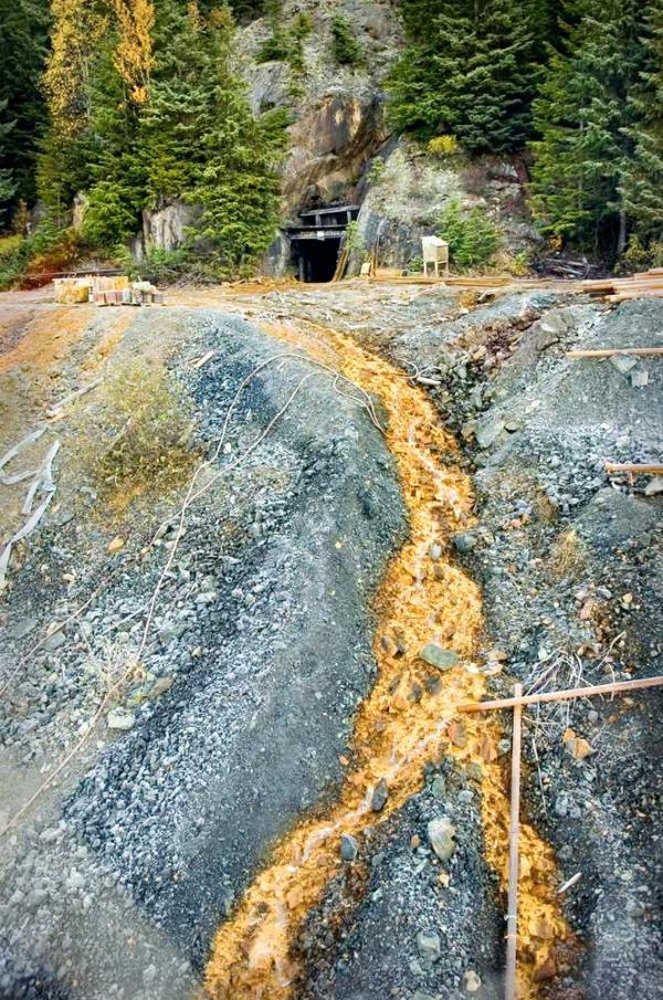British Columbian officials have told the owners of a long-closed mine polluting the Taku River to come up with a plan to fix the mine’s problems in the next three months.
A Nov. 10 email signed by representatives of three agencies — the Ministry of Energy and Mines, the Ministry of Environment, and the Environmental Assessment Office — asks Chieftain Metals Corp. to “within 90 days … please submit an overall plan to bring the mine into compliance.”
Lieutenant Gov. Byron Mallott on Monday called the move “the first significant … action on the Tulsequah Chief Mine in some time.” The action results from Minister of Energy and Mines Bill Bennett’s August trip with Mallott up the Taku River to the site, which Bennett has said he found affecting. The two hovered in a helicopter overlooking acid mine drainage flowing directly into the river. Bennett later made statements in front of local media agencies saying he said he would take action.
“He was very impacted by that powerful visual,” Mallott said.
Some others, however, say the real test of British Columbia’s commitment to addressing the problem is what happens when those 90 days are up.
Rivers Without Borders Alaska Campaign Director Chris Zimmer wrote in an email that the recent inspections of the mine site show “the situation on site (is) worse than I had thought.”
“There is the ongoing acid mine drainage and closed water treatment plant that we all know about, but the inspections also found fuel spills, inadequate storage of grease, unapproved construction and operation of sludge dumps, leaking fuel tanks, inadequate monitoring and pollution incidents that were not reported,” he wrote.
This isn’t the first time owners of the Tulsequah Chief Mine have been asked to clean up the pollution leaching into the Taku River. In 2009, then-owner and also bankrupt Redcorp Ventures Ltd. and subsidiary Redfern Resources was ordered by the Canadian government to clean up the acid. In 2012, Chieftain, then the owner, stopped the interim water treatment plan at the site after less than a year.
In her conclusion, Deputy Chief Inspector Diane Howe wrote that “CMI continues to fulfill their obligations for monitoring and maintenance of the site … (but) communication with the Province with respect to obtaining approvals and reporting issues needs to be improved.”
The Oct. 15 Ministry of Energy and Mines inspection also noted a pipe emptying acidic discharge directly into the river, something the report noted also happened last year during “the high flow period.”
“MEM understands this direct discharge has not approved (sic) by MOE (Ministry of Environment) and discussions are ongoing,” the report adds.
“It is good that Bennett made these inspections happen, but the cleanup orders are weak and inadequate to stop the ongoing pollution,” Zimmer wrote. “The real test here is what is actually done on the ground at the mine site in response to the inspections. Given that Chieftain is almost bankrupt and hasn’t been able to attract investors, I am doubtful that they will do much.”
Chieftain Metal representatives did not return calls requesting comment by press time.
Tests by several different entities have found that fish in the Tulsequah River are not being affected by the discharge, something Deputy Commissioner of the Department of Commerce, Community and Economic Development Fred Parady said at a Monday intergovernmental meeting is “really a function of the volume of the river as opposed to the intensity of the discharge,” adding “I think there’s work (that) remains to be done there.”
• Contact Juneau Empire outdoors writer Mary Catharine Martin at maryc.martin@juneauempire.com.

